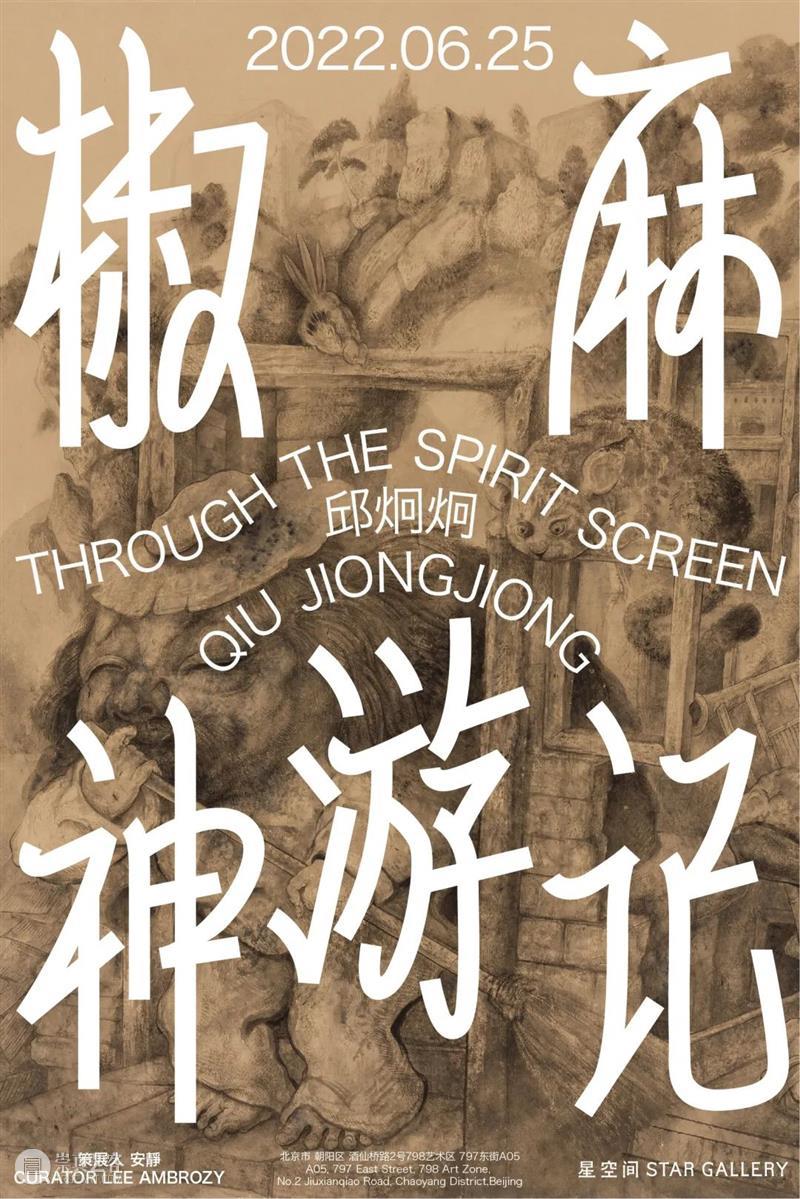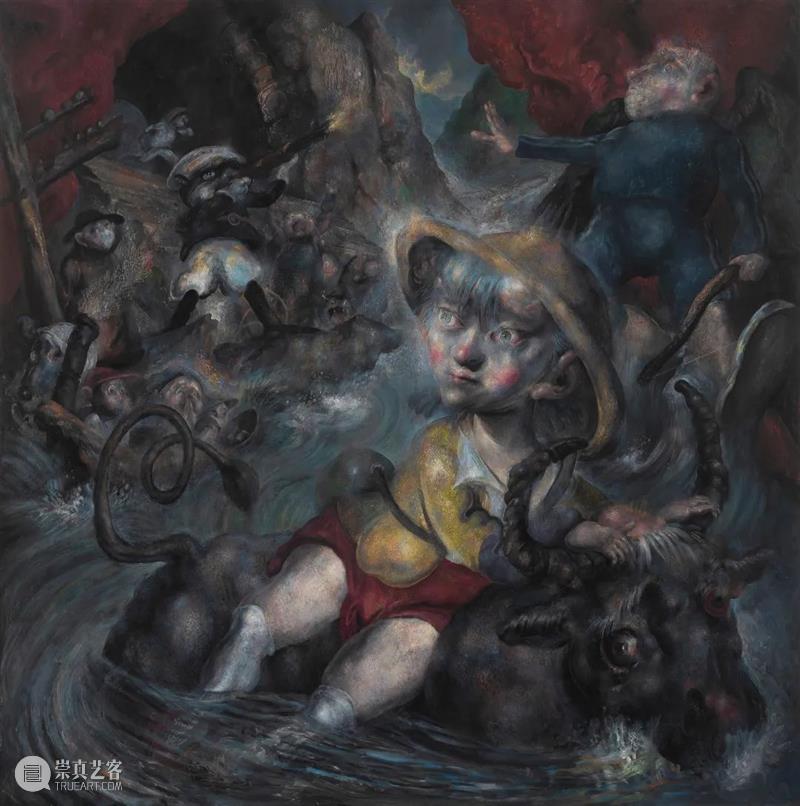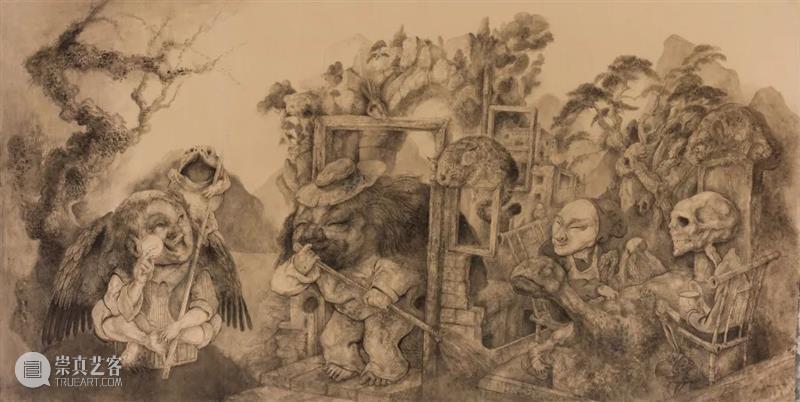
文 / 安静 ( Lee Ambrozy )
译 / 王袁
“椒麻神游记”汇集了邱炯炯六年多来的绘画,向我们揭示了其中层层叠叠的心理历史层次。他创作于2020年上半年的画作构成了邱炯炯故乡乐山的地方志,其中的人物或真实、或虚构,他们也同样出现在邱炯炯执导的传记影片《椒麻堂会》(2019)中。通过将分镜图、场景图、人物草图和纪念碑式的绘画并置呈现,我们可以细致地观察“双向异花传粉”是如何在邱炯炯的导演与绘画实践中发生的,并最终汇合为一个为他所独有的视觉宇宙。您将有机会像爱丽丝那样“穿镜而入”,透过他的双眼观看那个世界。作为展览的主轴,影片《椒麻堂会》(2019)述说了邱炯炯的祖父作为川剧名伶的一生和二十世纪的动荡不安。其中的某些人物是贯穿邱炯炯作品的永恒基调,在该片拍摄前、拍摄中与拍摄过后的绘画里,他们以一众古怪疯癫的角色出现,打趣讨喜、引人入胜,体现了艺术家对当代社会非凡的洞察力。邱炯炯使用油画、水墨、马克笔、色粉、铅笔和综合材料等各式各样的绘画媒材,承袭着古典和“老大师绘画”的主题,并按照他自身的时代、地理和文化语境进行了全新演绎。他曾将不平等的性别权力加以反转,在引入中西方艺术史的典故时,他始终探索着将其本土化和大众化。他无差别地驾驭着各类媒介去创造个人风格,无论是传统的绘画还是基于时间的电影。他旺盛的艺术创作不仅仅服务于俗常看客,即他笔下街头巷尾的人,也是在回应驱使他不断前进的绘画抱负:精进技巧、超越自我,令他那包罗万象的视觉世界至臻至善。凭借他独有的自学成才之手,邱炯炯用颜料层叠累积所形成的美学缔造了别具一格的天地,这源于艺术家对其表现对象的寻根究底和明察秋毫。邱炯炯瞄准世间百态的镜头是有纵深的。如果绘画可以被理论概括成一种“创造世界”的行为,邱炯炯则将画框所创造和框定的世界延展到了动态图像。架上绘画的木框与导演监视器的边框一样,都是进入某个时空的入口,在那里,邱炯炯就是造物主。如同他的影片,邱炯炯的绘画也能以时间度量,解锁这种时间感的不再是一帧帧活动的影像,而是被一笔一笔埋入层层颜料中的时光,这是艺术家劳作的证明。裸眼观看邱炯炯画作时,其绘画实践的强度最为显而易见。“椒麻神游记”提供了一个难得的机会,令他近年来的巅峰之作面对大庭广众。邱炯炯拥抱中西绘画大师,也不小看荒诞不经与下里巴人。或许是自我教育的经历,让他可以无视学院的正统训练,也忽略了风格与流派演进,而对生猛直接的表达钟爱有加。邱炯炯独树一帜的风格掀开了模拟现实主义(Mimetic Realism)的新篇章,他外在的起伏,不论是起伏程度还是质地,都正如他所具备且欣赏的自强不息和平易近人。“阅读”绘画,可以是一段旅程,也可能是一次除旧布新的经历。

铜河边的欧罗巴
Europa by the Dadu River
铝板油彩
Oil on aluminum
120 × 120 cm
2021
Through the Spirit Screen
Introduction by Lee Ambrozy
In "Through the Spirit Screen," the layered psychohistorical surfaces of Qiu Jiongjiong’s paintings are brought before us, collecting more than six years of his painterly output. A constellation of characters, real and imaginary, populate these scenes in which Qiu chronicles his hometown of Leshan during early 2020 and also intersect with his film biopic A New Old Play (2019). Through this complex juxtaposition of storyboards, scene graphs, character sketches, and monumental painting we can observe in detail how Qiu's film making cross-pollinates his painting practice and vice-versa, coalescing into a visual universe that belongs him alone. You are invited like Alice, to step "through the looking glass,” and see the world through his eyes. The film A New Old Play (2019) serves as the exhibition axis, it recaps his grandfather’s life as a Sichuan Opera performer and chronicles the tumultuous events of the 20th century. Some of these personalities are a constant theme in the artist’s oeuvre, and in the paintings (created before, during, and after it’s filming) reveal an expansive cast of eccentric and madcap personalities. They delight and fascinate, as they reveal the artist’s incisive observational skills into contemporary society. Working in a wide variety of mediums, oil, ink, marker, oil pastels, pencil, and mixed media, he takes on classical and Old Master Painting themes, reinventing them for his own temporal, geographic and cultural context, sometimes reversing gendered power imbalances, but always localizing, and democratizing tropes from western and Chinese art history. Every medium he wields conforms to his style with equal mastery, from the traditional media of painting to time-based media like film. His robust artistic practice responds to the everyday viewer––those people he paints from the street––just as much as it is responding to the painterly ambition that drives him. Qiu is driven by a technical imperative, the desire to surpass his own abilities, to work out the minutia of the visual macrocosm he has carefully crafted. Qiu Jiongjiong’s stylized cosmos emerged from his unique, self-taught hand, with an aesthetic that achieves form in the accumulation of paint layers, while it is rooted in a psychological inquiry into his subjects and observational prowess. Qiu’s lens on the world has depth. If painting can be been theorized as “world-making”––spaces and universes created and demarcated by the frame––Qiu bleeds his world into that of the moving image. The wooden frames around his canvases are like the edges of the screen monitor: they act as portals into a world in which Qiu is the master. And like his films, Qiu's paintings measure time, but in his paintings, this unfolds not through the moving image, but with the accumulation of time trapped in the layers of paint, an index of the artist’s labor. The intensity of Qiu’s painting practice is most apparent when beholding his canvases with the naked eye, and "Through the Spirit Screen" is a rare opportunity to see the culmination of his recent work in such a grand setting. While Qiu has absorbed from both Chinese and Western masters, he doesn’t shun the grotesque, or the vulgar. Perhaps it is because he is self taught that he can disregard the formal training of the academy, ignoring stylistic conventions and privileging raw expressions. His distinct style is a twist on mimetic realism, his surfaces undulate with just as much volume and texture as the fiercely independent yet charming characters who populate them (appeal to him). To "read" a canvas here is as much of a journey as it is a transformative experience.

地仙儿咏春图
Land Fairies’ Spring Chant
纸本水墨
Ink on paper
120 × 239 cm
2021-2022
关于艺术家
ABOUT THE ARTIST
邱炯炯,1977年生于四川乐山,现居北京。他自幼习画,并随祖父表演川剧,自学成才的他是艺术创作的多面手。邱炯炯的艺术重心聚焦于绘画,并从2006年开始创作了多部独立纪录片。故乡四川乐山和他那围绕川剧的家族史是邱炯炯作品中永恒不变的主题。他的最新影片《椒麻堂会》,也是他的第一部剧情长片,就围绕其祖父的一生展开。尚在制作阶段时,这部影片就获得了多个电影节的创投奖项;该片此后在第七十四届洛迦诺国际电影节的国际竞赛单元首映,并获得评委会大奖。“四川人”是画家邱炯炯根深蒂固的身份认同,四川方言也是赋予其电影独特文学魅力和叙事结构的重要因素。
Qiu Jiongjiong (b.1977) was born in Leshan, Sichuan, and lives and works in Beijing. Self-trained and poly-skilled in the creative arts, Qiu began painting at a young age and performing Sichuan opera shortly after. The majority of his artistic output is focused on painting and since 2007 he has competed several independent documentary and feature films.
His hometown of Leshan, Sichuan Province and a family history in the opera are constant themes within his oeuvre. The life of his grandfather is the centerpiece of his most recent film and first feature film, A New Old Play (2021), whose screenplay won several awards during production, and which premiered in the international competition section of the 74th Locarno International Film Festival, winning the Jury Prize.
Qiu’s Sichuanese identity is deeply embedded in his identity as a painter, as Sichuan dialect is important features contributing to the unique literary interest and narrative structure of his films.
关于策展人
ABOUT THE CURATOR
安静,中国晚唐至宋朝艺术专家,纽约大学艺术学院博士生在读,研究课题是自然界的图像在中国早期市井艺术及物质文化中的流传。曾在中国从事当代艺术工作超过十五年的安静经验丰富。她从中央美术学院获得硕士学位,论文主题是毛时代民族主义对传统水墨的利用。她是《艾未未博客》(麻省理工学院出版社,2011)的编辑和译者,也是第一部具有开创性意义的中文现代艺术文本《白立方内外:ARTFORUM当代艺术评论50年》(三联出版社,2017)的编辑。目前,定居于底特律的安静正在适应后疫情时代瞬息万变的世界文化图景,间或从事写作、策展和翻译工作。
A specialist in Chinese art from the ninth through eleventh centuries, Lee Ambrozy is a Ph.D. candidate at New York University’s Institute of Fine Arts, where her research examines how images from nature circulated within early urban China’s art and material culture. She has more than fifteen years of expertise working with contemporary art within China, and obtained her M.A. at Beijing’s Central Academy of Fine Arts with a thesis discussing the nationalist uses of traditional ink painting under Mao. She was editor and translator of Ai Weiwei's Blog (MIT Press, 2011) and editor of the first publication of seminal modern art texts in Chinese, Inside the White Cube: Artforum Fifty years of Art Criticism (Sanlian Books, 2017). She is currently based in Detroit, where she writes, curates exhibitions, and translates on occasion, adapting to the changing cultural landscape in the Post-Pandemic world.

798 Art Zone, No. 2 Jiuxianqiao Road, Chaoyang District, Beijing, China 100015












 分享
分享